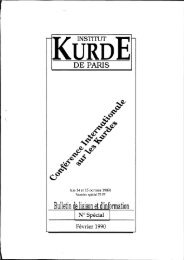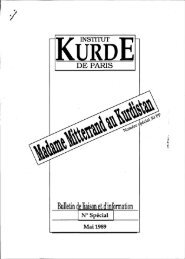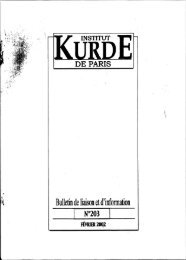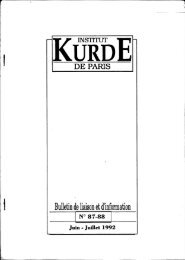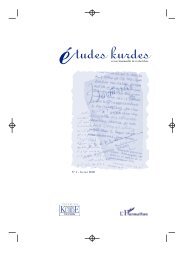Create successful ePaper yourself
Turn your PDF publications into a flip-book with our unique Google optimized e-Paper software.
Revue <strong>de</strong> Presse-Press Review-Berhevoka Çapê-Rivista Stampa-Dentro <strong>de</strong> la Prensa-Baszn Ozeti<br />
ft<br />
o~"";',.,<br />
~'\'i<br />
~_ ]lhe Kurdish Globe December 19,2006<br />
The Kurdish case<br />
for Kirkuk<br />
By Dr. Nouri Talabany<br />
The Globe<br />
While Kirkuk's <strong>de</strong>mography<br />
has been in flux in<br />
recent <strong>de</strong>ca<strong>de</strong>s, largely a<br />
result of ethnie c1eansing<br />
campaigns implemented<br />
by Ba'athist regime of<br />
Sadam Hussein, but wh en<br />
free from that regime,<br />
many Kurdish refugees<br />
have returned to their<br />
homes in the city and<br />
its immediate environs.<br />
Many diplomats and ana-<br />
Iysts may be tempt ding<br />
to <strong>de</strong>lay <strong>de</strong>cisions about<br />
the final status of Kirkuk,<br />
whether it should remain<br />
as if is, or joins Iraq's<br />
Kurdistan Region, any<br />
<strong>de</strong>lay could be counterproductive<br />
to the goals of<br />
peace and stability.<br />
A Mixed City<br />
Historically, the majority<br />
of the clty's population was<br />
Kurdlsh and Turcoman.<br />
The Turcomans traced their<br />
famIlles back to the Ottoman<br />
era. Later, Arabs began<br />
to settle in the region. Writmg<br />
of the ethnic compositIon<br />
of the city, the Ottoman<br />
encyclopaedist Shamsaddin<br />
Sami, author of the Qamus<br />
al-A'lam, pubhshed in Istanbul<br />
m 1897 found that,<br />
"Three quarters of the inhabItants<br />
of Kirkuk are<br />
Kurds and the rest are Turcomans,<br />
Arabs, and others.<br />
Seven hundred and sixty<br />
Jews and 460 Chal<strong>de</strong>ans<br />
also resi<strong>de</strong> in the city."<br />
The Kurds predate other<br />
resl<strong>de</strong>nt groups; the northem<br />
and eastem districts of<br />
the clties have been traditionally<br />
Kurdish. Turcomans<br />
later migrated to the<br />
region. According to the<br />
Encylopedla of Islam, the<br />
local Kurdish population<br />
m Kirkuk was Joined by a<br />
Turcoman minonty as far<br />
as the ninth century C.E.,<br />
when caliphs installed<br />
Turcoman garrisons in the<br />
region. ln his history of<br />
the vanous Iraqi provinces,<br />
Iraql hlstorian Abdul Majid<br />
Fahml Hassan placed the<br />
Turcoman migration in the<br />
52<br />
mld-seventeenth century<br />
when Ottoman Sultan Murad<br />
IV wrested the region<br />
from Iranian control. As<br />
Murad returned to Istanbul,<br />
he left army units III position<br />
to control the strategic<br />
route Imking Baghdad and<br />
Anatolia; the Iraqi Turcomans<br />
<strong>de</strong>scen<strong>de</strong>d from these<br />
troops. Promment Turcoman<br />
famlhes in Kirkuk,<br />
such as the Neftçiler and<br />
Awçi, trace their ancestry to<br />
Murad's troops; moreover,<br />
the prominent ethmc Arab<br />
Tikriti family also traces<br />
their presence in the region<br />
to Murad's soldiers, and the<br />
Sultan's gift of land in and<br />
around Kirkuk as a reward<br />
for their military service<br />
against the Iranians.<br />
ln the late Ottoman period,<br />
Kirkuk was the administrative<br />
center of the wilayet<br />
(province) of Sharazur. ln<br />
1879, it became a sanjak<br />
(district) within the vilayet<br />
of Mosul. Further changes<br />
occurred in the reglon ln<br />
1918 when the British army<br />
occupied the Mosul wilayet<br />
and created a new Arbil<br />
govemorate. ln 1921, the<br />
British estimated the population<br />
of the Kirkuk region<br />
to be 75,000 Kurds; 35,000<br />
Turcomans; 10,000 Arabs;<br />
1,400 Jews; and 600 Chal<strong>de</strong>ans.<br />
A League of NatIons<br />
Committee that visited<br />
the Mosul wilayet in 1925<br />
estimated that the Kurds<br />
comprised 63 percent of<br />
Kirkuk's population, the<br />
Turcomans, 19 percent, and<br />
the Arabs, 18 percent.<br />
Many Kurds grew crops<br />
and raised livestock near<br />
the streams and wells in the<br />
northem and eastem parts<br />
of the Kirkuk region while,<br />
in the city of Kirkuk, Arab,<br />
Assyrian, and Armenian<br />
migration to the city accelerated<br />
after the 1927 discovery<br />
of oil. From 1935,<br />
Arab families migrated to<br />
the nearby Hawlja plain,<br />
southwest of Kirkuk, after<br />
the Iraqi govemment<br />
launched a large-scale irrigation<br />
project to open the<br />
drier southwestern portion<br />
of the region to agricul-<br />
ture. Other Arabs settled in<br />
Kirkuk as civil servants or<br />
serving as officers and soldiers<br />
in the Second Division<br />
of the Iraqi army, most<br />
of whlch was stationed in<br />
Kirkuk.<br />
Because there was no<br />
census taken in Iraq until<br />
]947, however, such figures<br />
are estimates, and the<br />
]947 census itself is of little<br />
help because its glves no<br />
precise <strong>de</strong>tails of the ethnie<br />
composition of the population.<br />
However, the ]957<br />
-wi<strong>de</strong>ly acknowledged as<br />
the most valid because it<br />
was the least politicizedbroke<br />
down population<br />
by rnother tongue, finding<br />
Kirkuk was 48.3 percent<br />
Kurd, 28.2 percent Arab,<br />
21A percent Turcoman,<br />
and the rest Chal<strong>de</strong>an, Assyrian,<br />
or other.<br />
While <strong>de</strong>mography might<br />
shift with time, Klrkuk's<br />
various communities have<br />
a long history of coexistence.<br />
PolitIcally, Kurds<br />
have a long tradition of<br />
lea<strong>de</strong>rship in Kirkuk. On a<br />
natIOnal level, most Kirkuk<br />
representatives in the lraql<br />
parliament were Kurds<br />
and a smaller number of<br />
Turcomans. Local Arab<br />
representatives entered the<br />
parliament after settlement<br />
of the Hawija region. ln<br />
the late Ottoman era, the<br />
sultan's governors mostly<br />
nommated Turcomans as<br />
mayor although, on certain<br />
occasions, Kurds also held<br />
People <strong>de</strong>monstratlng agalnst Kirkuk Arabization process<br />
and <strong>de</strong>mand nonnalizatlon ofthe city.<br />
monarchy, that many Turcomans<br />
became mayors.<br />
The first Arab mayor took<br />
office m ]969, when the<br />
Baatlllst reglme appointed<br />
Muzhlr al-TikntI.<br />
Vnttl ]955, the Kirkuk<br />
had just one high school<br />
and the majonty of the stu<strong>de</strong>nts<br />
had Kurdish and Turcoman<br />
backgrounds, with<br />
smaller numbers of Arabs,<br />
Assynans, Chal<strong>de</strong>ans, and<br />
Armenians. Most Arab stu<strong>de</strong>nts<br />
were the children of<br />
civil servants, military personnel,<br />
or employees of the<br />
Iraqi Petroleum Company<br />
(IPC).<br />
By long-standing tradition,<br />
the Kurds, Turcomans,<br />
Chal<strong>de</strong>ans, and Jews have<br />
had their own cemeteries.<br />
The Arabs, being a minority,<br />
buried their <strong>de</strong>ad in<br />
the Turcoman cemeteries.<br />
However, in ]99], Saddam<br />
Hussein 's government created<br />
special ce:meteries for<br />
Arab settlers and banned<br />
Arab Shi'ites from taking<br />
their <strong>de</strong>ad back to Najaf for<br />
bunal in or<strong>de</strong>r to bolster<br />
the Arab claim to the city.<br />
The Baathist regime subsequently<br />
began to rewrite<br />
Kurdish tombstone inscriptions<br />
wlth Arabic in or<strong>de</strong>r<br />
to retroactively alter the<br />
<strong>de</strong>mography.<br />
Ethnie Cleansing<br />
The Ba'athists sough<br />
to implement their Arab<br />
nationalism by force. ln<br />
Later, during June 1963, the short-lived<br />
Ba'athist regime of Ali<br />
Saleh al-Sa'adi <strong>de</strong>stroyed<br />
thirteen Kurdish villages<br />
around Kirkuk and expe1\ed<br />
the populatIOn of<br />
another thirty-four Kurdish<br />
vi1\ages in the Dubz dls-<br />
the position.<br />
the monarchy, Kirkuk's<br />
mayors were mostlY Kurds<br />
from the Talabany family.<br />
It was only during the late<br />
Ottoman era and the Iraqi<br />
trict near Kirkuk, replacing<br />
them with Arabs from centrai<br />
and southern Iraq.<br />
After the Baath party consolidated<br />
power in ]963,<br />
the National Guard (al-<br />
Haras al-Qawmi), recruited<br />
Arab Ba'athists and Turcomans<br />
who systematically<br />
attacked ethnic Kurds. Between<br />
]963 and 1988, the<br />
Ba'athist regime <strong>de</strong>stroyed<br />
779 Kurdish villages in<br />
the Kirkuk region-razing<br />
493 pnmary schools, 598<br />
mosques, and 40 medical<br />
chmcs. ln or<strong>de</strong>r to prevent<br />
the return ofthe Kurds, they<br />
burned farms and orchards,<br />
confiscated cattle, blew up<br />
wells, and obliterated cemeteries.<br />
ln ail, this ethmc<br />
c\eansmg campalgn forced<br />
37,726 Kurdish families<br />
out of their VIllages. Given<br />
the average rural Kurdish<br />
family slze of between<br />
five and seven people, this<br />
policy forced over 200,000<br />
Kurds to flee the region.<br />
The Kurds were not the regime's<br />
only victims. During<br />
the Iran-Iraq war, the centrai<br />
govemment <strong>de</strong>stroyed<br />
about ten Shi'ite Turcoman<br />
villages south of Kirkuk.<br />
The Iraqi government also<br />
compelled urban Kurds to<br />
leave Kirkuk. It transferred<br />
0!1. company employees,<br />
CIVil servants, and teachers<br />
to southern and central<br />
Iraq. The Ba'athist government<br />
renamed streets<br />
and schools in Arabic and<br />
forced businesses to adopt<br />
Arab names. Kurds could<br />
only se1\ real estate to Arabs;<br />
non-Arabs could not<br />
purchase property in the<br />
city. The government allocated<br />
thousands of new<br />
resi<strong>de</strong>ntial units for Arabs





